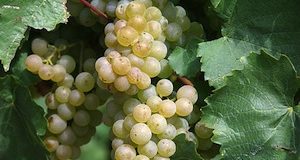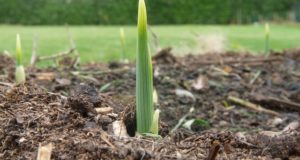|
Listen To The Article
|
 Whether you are fully self sufficient, in a transitional in-between stage, or just a dabbler in do-it-yourself projects, making your own wine is a fun, relatively easy, and very satisfying endeavor. Good results are not difficult to produce, and with a little practice and familiarity with your variables, truly great results are within most folks’ reach. Growing your own fruit for wine-making adds a layer of complexity, primarily in terms of time invested before you have results, but it also means a level of control and “wholism” to your project: you control inputs from start to finish.
Whether you are fully self sufficient, in a transitional in-between stage, or just a dabbler in do-it-yourself projects, making your own wine is a fun, relatively easy, and very satisfying endeavor. Good results are not difficult to produce, and with a little practice and familiarity with your variables, truly great results are within most folks’ reach. Growing your own fruit for wine-making adds a layer of complexity, primarily in terms of time invested before you have results, but it also means a level of control and “wholism” to your project: you control inputs from start to finish.
Getting Started
First things first: where do you live? Many of the choices you will need to make are born of your location: your climate, weather, and soil will shape your decisions. In some areas, the grape varieties used practically define the geographical region: think Bordeaux or Champagne in France. In other regions in the United States, other fruits are preferred for the making of alcoholic beverages, as grapes are not necessarily the best choices.
In the Hudson Valley region in Upstate New York, for example, a resurgence of interest in growing hops has lead to the effort to reestablish this area, the nation’s foremost hops growing region during the Revolutionary War, as a national supplier of hops, invigorating local beer-brewing industries. Similarly, the legalizing of black currants after decades of prohibition due to a cross contamination with disease affecting white pines has given rise to a significant increase in local commercial production of cassis. The Mid-Hudson Valley is also well known for its apple production, and hard cider, or blended cider with other tree fruits has therefore taken off in this region. Taking a look at trends in your region for what commercial growers are doing successfully, and perhaps more importantly, what steps have been taken to ensure success, is a good first step.
Do Your Homework
You will need information in order to set yourself up for success, but the amount of information available can be overwhelming. Sifting through the numerous websites, online forums, books, and “real life” groups or clubs to get the information you need can be a project. The best approach, when possible, is to connect with others in your area who are already growing. Most regions have clubs or networks where growers share information and offer informal mentorship to those just starting out.
Take a scholarly approach to your site. Take soil samples and have them analyzed at your local cooperative extension. Acidity/alkalinity and soil composition (Clay? Sand? Rock? Mineral?) as well as the specifics of your site (South-facing? Protected? Exposed? Well-drained?) will influence the varieties you select. Most experts suggest digging a test pit, approximately four feet deep by two feet wide, to check for the existence of hardpan and other issues. Ask if there is a pomologist (fruit expert) or enologist (wine expert) available via the cooperative extension or closest university who can offer advice and insight, either in person or via a website. Often cooperative extension services include a site visit by an expert who can do a hands-on assessment of your specific area and offer feedback and suggestions.
Also consider the size of your site, and the quantity of wine you wish to produce. Setting up a vineyard area may require extensive site prep, fencing, and access to water. Consider all your options in completing your site prep to avoid future problems down the road. Once planted, you are committed and making significant changes can be difficult and time consuming. Take your time and ask all your questions prior to planting. You’ll be glad you did.
Hybrids
Many of the wine grapes grown in the United States are hybrids made by crossing native species with French wine grapes. The purpose in doing so is to develop varieties that have the vigor and pest and disease resistance found in native species while maintaining or enhancing the flavor profiles of the European grapes. Key concerns include late inter/early spring uncertainty and the risk of a late frost, pests and diseases, and both drought and flood conditions, all of which are increasingly problematic across the United States and in all agricultural enterprises. Hybridization is one way in which growers can hedge their bets at least somewhat in an effort to maintain production despite uncertainty.
Some Grapes to Consider
Seyval Blanc is a hybrid resulting from a cross of native American and French grapes. This hybrid, along with the French Chardonnay grape and the red Cabernet Franc grape, are the most commonly planted in New York’s Hudson Valley. Well suited to the soils, climate, weather, and pest/disease issues of this area, consider these varieties of you are growing in a region comparable to the Hudson Valley. Further north in New York, and more inland, the Finger Lakes region is well known to produce excellent wines. Again, the Cabernet Franc grape is popular in this region, particularly for its cold tolerance, and the Riesling is another European variety that grows well and produces excellent wines (although drier than their German counterparts) for Finger Lakes growers. In the southern United States, you might try muscadine or scuppernong grapes if you are looking for a more regional flavor.
Blending
The fun begins! As you gain experience and confidence, you may find that teaming up with another grower to share juices can result in really exciting blends. Or, if you have the room, grow multiple varieties to blend. Blending is common among wine-makers in areas where varietals do not perform as well as in their native homes and can yield excellent and consistent results. Again, ask around in your area to determine what varieties to blend.
For more information:
Growing in Texas? Check this site out for basic “getting started” information: https://vintagetexas.com/blog/?p=1382
Preparing your soil?
Want more details about specific grape varieties and their flavor profiles? This link describes a number of grapes grown in the Hudson Valley region in New York State: https://www.hudsonvalleywinecountry.org/grapes.html
More details about native grape, European grape, and hybrid species and wine production in the Finger Lakes Region in New York State can be found here: https://www.stayfingerlakes.com/wine/grape-varieties.htm
 Off The Grid News Better Ideas For Off The Grid Living
Off The Grid News Better Ideas For Off The Grid Living




